
Original Link: https://www.anandtech.com/show/2073
Introduction
The high performance market is usually the place to look for the most exciting and powerful graphics solution, but few real world gamers can afford to shop there. While budget and mid-range parts may not be as interesting as the newest and fastest graphics cards out there, there are many decent parts available. These lower-priced cards may not be as fast as their high-priced companions, but besides the benefits they offer your bank account, many also provide features that are not generally available on the higher-end products.
While AMD and more recently Intel have been focusing on lower power consumption for their CPUs, the GPU market is still very focused on high performance, high power consumption designs. ATI and NVIDIA have been engaged in a performance arms race, much like the race several years ago between AMD and Intel that culminated in the power hungry NetBurst architecture. Thankfully, that era is mostly past on the CPU front, but we're still left with top-end GPU configurations that can often consume as much power as the rest of the system. However, not everyone is willing to sacrifice all other aspects of their computer design in the pursuit of speed.
Life is tough as an add-in card vendor, making video cards for ATI/NVIDIA. The cards are basically all the same and it's not really easy to add value in the form of additional features to a video card. In the past, third party board makers have used clock speeds, game bundles, technical support/warranty and more robust cooling to differentiate their products in the market. With the new focus on building quiet PCs, noise output is yet another way for these guys to differentiate product.
All this leads us to today's topic: enter the Silent Graphics Card, a graphics card that is completely passively cooled, often using heat pipes and an oversized heatsink to eliminate the need for a fan to keep the GPU/memory cooled. The idea of a quiet or silent graphics card is appealing to many types of computer users, and many card manufacturers have realized this and are offering silent solutions. In the past, the only passively cooled video cards were slow entry level offerings. This is no longer true, and you can now get many mid range GPUs that offer reasonable performance without any noise output. The highest end GPU solutions are still all actively cooled, but if you're looking at any of the more affordable GPUs, you may be able to find a passively cooled alternative.
One of the most important parts of a graphics card is the heat sink. All processors can potentially get extremely hot while crunching calculations, and it's the heat sink's job to expel all that heat so that the processor remains stable. A processor is somewhat fragile and if it has inadequate or improper cooling, the excess heat can damage it. With graphics chips getting faster all the time comes the need for better and more efficient cooling solutions. The amount of heat a heat sink can dissipate is dictated by, among other things, the amount of surface area and the size of the heatsink. Larger heat sinks can dissipate more heat, but there's a practical limit to how large your heat sink can get. Adding a fan allows the use of a smaller heat sink with less surface area, but without one you have to increase surface area, thus giving most of these silent cards very large, elaborate, heat sink designs.
As with most things in life, there are compromises to be made. Dual-slot GPUs sacrifice size for improved cooling, often at the expense of other expansion options. In some cases like the 7900 GTX, the larger HSF design results in higher performance as well as lower noise levels, but while quieter than other high-end GPUs the 7900 GTX is still not silent. Many gamers are willing to give up potential future use of a PCI or PCIe slot in order to get the improved performance that comes with 7900 GTX and X1900/X1950 cards. Others will also be willing to give up expansion options in order to reduce noise levels. Single-slot silent GPU solutions are still possible, but they typically come with lower performance in order to reduce heat output.
With all this in mind, we've put together a roundup of a large selection of completely silent graphics cards from several manufacturers. Our requirements are that all entrants in this roundup be passively cooled - water cooling solutions may be interesting to some people, but they still require a radiator and often involve a lot more work getting everything set up and installed properly. We are going to be looking at which of these cards offer the best value for performance, and we'll also show what types of games and settings are playable for each GPU. One question that some people will want to know is which of the silent solutions offers the best performance, and our benchmarks will look to provide an answer. In addition, we will look at what kind of power loads and heat levels we see can expect with these cards. Finally, we will determine how well the various offerings overclock above the factory clock speeds.
Stability is also going to be a concern, as many of these silent solutions may only work properly in the presence of other fans. Building a completely silent PC - i.e. no fans at all - presents some difficulties during long periods of operation, as heat buildup will occur within the case unless some mechanism for removing it is present. Passively cooled power supplies, CPU heat sinks, motherboards, and GPUs all exist, but putting all of them into the same case without at least one fan to provide air flow may be going too far. This is a topic that we will look to address in a future article, and we would encourage the use of discretion on the part of those looking to eliminate noise. A single slow-moving fan can dramatically reduce case temperatures without generating much noise at all.
We'll be looking at cards from several different manufacturers, and we've grouped the offerings accordingly. We have both ATI and NVIDIA cards from ASUS, Gigabyte, HIS, EVGA, Albatron, Sparkle, and MSI. The cards range from the X1300 and 7300 GS on the low end to the X1600 XT and 7800 GT on the high end. There are a lot of cards to look at, so without further ado, lets start by looking at some silent graphics solutions from ASUS.
ASUS
We start our silent card roundup by looking at some cards by ASUS, a company that has impressed us with its quality in the past. For this roundup, ASUS has submitted four silent NVIDIA cards and a silent ATI card.

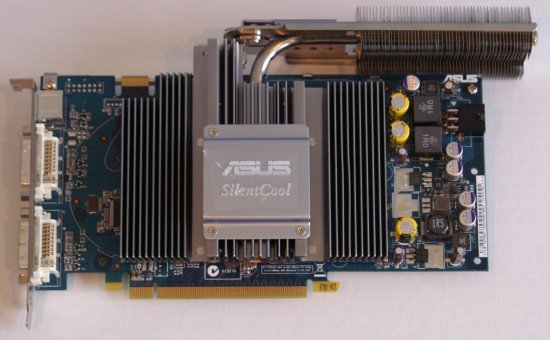
First we have the ASUS NVIDIA GeForce EN7800 GT Top Silent, a powerful card considering its silent design. As its name implies, the EN7800GT uses NVIDIA's 7800 GT GPU. This is an interesting card because, aside from its high performance GPU, its heatsink is designed with an arm extending from the side of the card that has the ability to swivel out 90 degrees so that air being pulled from the CPU fan can provide extra cooling. The arm can also remain closed if space is an issue, and the card still works fine. This is also the most powerful silent card we have for this review, and it comes with a slightly higher factory clock than a standard 7800 GT (420MHz/1.24GHz).
Second, we have the ASUS NVIDIA GeForce 7600 GS Silent 512. As the name suggests, this card has 512 MB memory instead of the standard 256 MB and is based on NVIDIA's 7600 GS GPU. However, the memory clock speed is set significantly lower than the standard 256 MB 7600 GS (540MHz vs. the standard 800MHz). This card as well as the 256 MB version have metal heat sinks that cover the front of the card, and curl over the top and down the back about an inch.

The ASUS NVIDIA GeForce 7600 GS Silent is the 256MB version of the above card. It's factory clocked the same as a standard 7600 GS, with a 400MHz core and an 800MHz memory clock speed. Both the 512 MB and 256 MB versions of this card look exactly the same. It is possible that when Windows Vista becomes available, the added memory of the 512MB version will prove useful, but at present there's little reason to recommend having additional RAM at a slower clock speed.
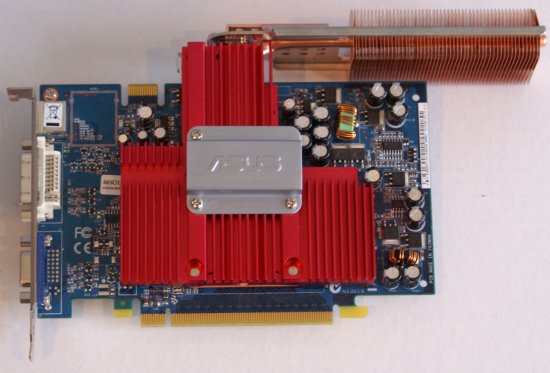
The ASUS EN6600 GT Silencer is very similar in design to the EN7800 GT Top Silent, with a rotating-arm heat sink that extends from the side of the card. The EN6600 GT's heat sink is a bit smaller and lighter than the EN7800 GT, which makes sense given the 6600's smaller size. Also similarly to the EN7800 GT Top Silent, this is the only card of its kind (6600 GT) in this review. On the NVIDIA side, our main focus will be on 7600 and 7300 cards, and for ATI the X1300 and X1600 offerings.
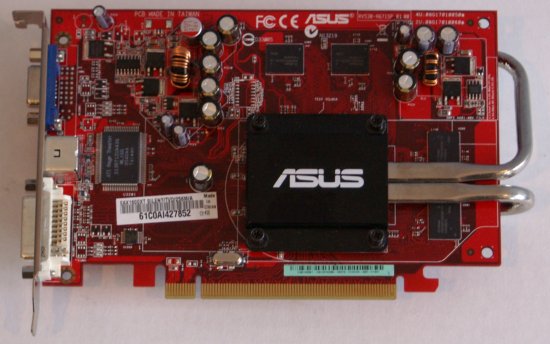
And lastly, we have an ATI offering by ASUS: the Radeon EAX1600 XT Silent. This is our most powerful ATI card for this review, and this particular X1600 XT has an interesting heat sink design. There is a small black heat sink on the face of the card just covering the processor, and two metal heatpipes extend around the end and to the back of the card, which holds a much larger heat sink. We will list the current prices for these as well as the rest of our cards in the "Cards Summary and Prices" section later on.
Gigabyte

Gigabyte has a lot of experience in the silent graphics market, and we have several ATI and NVIDIA cards from them for this review. An interesting statistic is that 90% of Gigabyte's shipped graphics solutions are silent, which makes a statement about the desirability of silent cards. Gigabyte is well represented in this review, having provided us with the highest number of solutions for testing. While their cards may not win any awards for good looks (the gold and turquoise coloring and unique heat sink designs aren't very easy on the eyes), they apparently handle silent operation very well, even at higher-than-stock clock speeds.
On the NVIDIA side, we have the Gigabyte 7600 GT, 7600 GS, 7300 GT, and 7300 GS. The Gigabyte 7600 GS comes shipped with its core overclocked to 450MHz, slightly higher (by 50MHz) than the stock version of this card. The Gigabyte 7300 GT also has a factory overclock of 450MHz core clock as opposed to the standard 350MHz core clock and an 800MHz memory clock verses the standard 667MHz memory clock on the 7300 GT. On the ATI side, we have the Gigabyte X1600 XT, X1600 Pro, X1300 Pro and X1300. All other Gigabyte cards aside from the 7600 GS and 7300 GT are clocked at reference speeds.

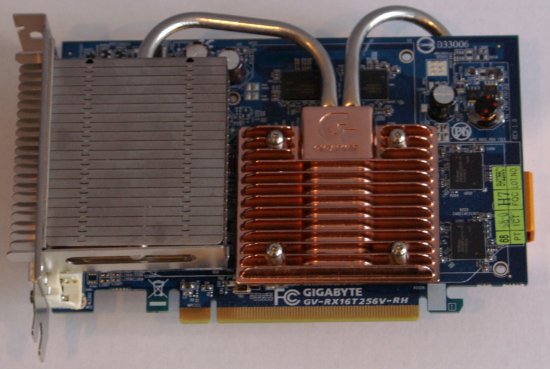

As we can see, the Gigabyte NVIDIA 7600 GT, ATI X1600 XT, and ATI X1600 Pro all have almost identical heat sink designs. The heat sinks are unique, with a bulky sink up front towards the DVI connections and heatpipes connecting to other heat sinks on the front and back of the card. The Gigabyte cards with this style heat sink are much more bulky than the other ones, and it's important to note that the silver heat sink uses up a second slot making these dual-slot solutions.

The Gigabyte X1300 Pro looks almost the same as the previous three Gigabyte cards; however, it is missing the extra heat sink on the back and the second metal pipe that would extend to it. The silver heat sink on the front still takes up an extra slot however, which is a point against this and the other three cards.

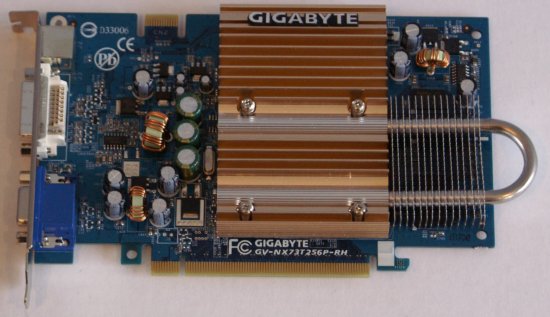
The Gigabyte 7600 GS and 7300 GT are very similar in appearance. The heat sinks on these cards are much more compact than those on the first four cards we mentioned. These cards don't take up an extra slot and only have a gold heat sink on the front, with a strange looking heatpipe running out and back in a "U" shape from the main heat sink. The heatpipe is attached to thin metal sheets, all in the name of increasing surface area and removing heat from the hotter portions of the card. These thin metal sheets seem a little delicate and might bend if the card is mishandled, though a slightly bent heat sink fin isn't really a major problem.
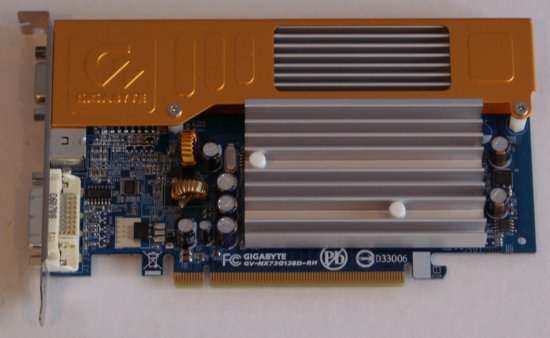
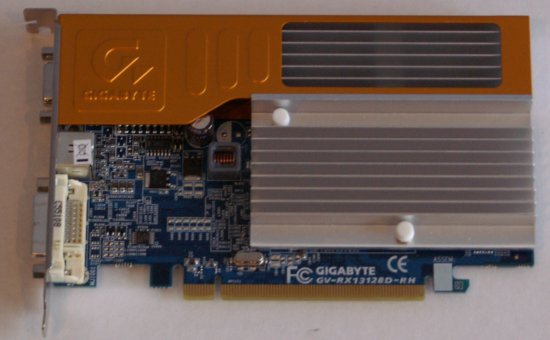
The Gigabyte 7300 GS and X1300 have heat sinks with a unique type of gold cover or hood running along the top part of the cards, over a silver heat sink on the cards' processor. The Gigabyte 7300 GS doesn't have a bridge connector on the top of the card for SLI operation, but it will still run in SLI (with a second card) without the bridge connection.
Gigabyte seems to have a definite plan about their custom heat sink designs, and after testing and overclocking these cards, there isn't much doubt that they perform well. They did, however, tend to get very hot to the touch after repeated testing, to the point where they became difficult to hold. We'll talk more about how well these cards overclocked in the "Overclocking" section.
HIS

HIS is a company that's well known for its IceQ line of graphics parts, but they also offer silent solutions, and for this review we have two of these. Both use ATI chipsets: the X1600 Pro and X1300 Pro.
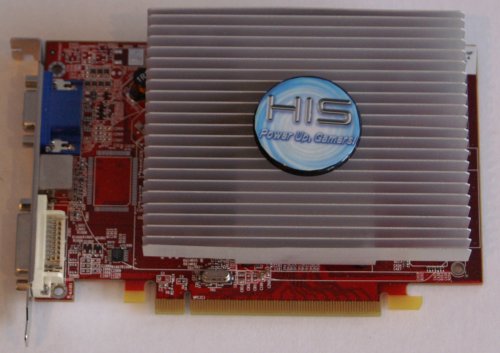
The HIS X1600 Pro has a somewhat bulky heat sink design, which has rows of long metal ridges along the whole top of the card. HIS seems to have taken the route of dispelling heat through as much surface area on the heat sink as possible, to good effect. The metal ridges are also much thicker than those on other heat sinks, and the card isn't as delicate as some of the other offerings.
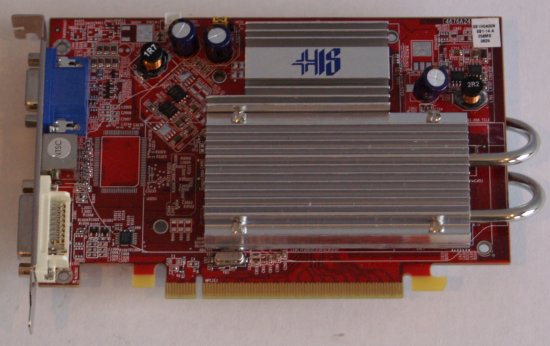
The HIS X1300 Pro has a much more compact heat sink design which extends to the back of the card and is connected via two heatpipes, similar to the ASUS EAX1600 XT. This HIS card has a larger silver heat sink than the ASUS on the front of the card, however, along with a slightly larger sink on the back of about the same thickness.
EVGA

For this review, we have one silent EVGA part, the EVGA e-GeForce 7600 GS. This card is factory clocked at reference speeds (400MHz/800MHz), and sports a modest heat sink design, typical of EVGA. The face of the card has a black heat sink which has rows of thick ridges across the length of it.
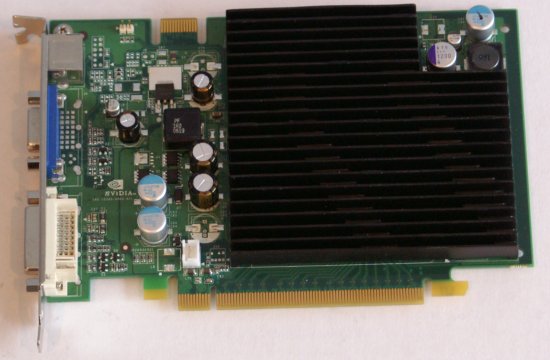
Albatron

We also have a single card from Albatron, the Albatron NVIDIA GeForce 7300 GT. This card comes with a core clock of 400MHz, 50MHz higher than stock, and an 800MHz memory clock, like the Gigabyte 7300 GT.
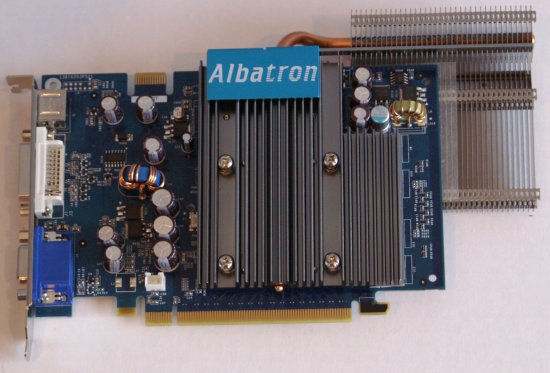
The Albatron 7300 GT almost looks as though the design was inspired partly by the silent ASUS 7800 GT and 6600 GT. The face of the card has a metal heat sink with vertical ridges on it, and extending from the top of the card is an arm with lots of added metal plates that at first glance looks like it might be able to swing out ASUS style. The arm is fixed in place however, and the extra bit of heat sink adds about an inch an a half to the length of the card. The metal plates on the extended part of the heat sink are very thin and because they stick out a good bit from the rest of the card they can be damaged easily.
Sparkle

Sparkle provided us with a card that is somewhat unique compared to our other silent solutions in this review. We have a single Sparkle card, the NVIDIA GeForce 7300 GS Ultra 2, and it happens to be the smallest card of the group. The 7300 GS Ultra 2 looks almost as if someone took a notebook NVIDIA 7200 card and put a desktop style heat sink on it that wraps from the front around to the back. Interestingly, the Sparkle 7300 GS Ultra 2 is clocked lower than the other 7300 GS cards, with a core clock of 550 MHz, and a memory clock of 532 MHz. The combination of the 7300 GS chipset with slower memory proves to be one of the slowest in the group, although for tasks that don't require a lot from the GPU it will still work. It's also capable of functioning as a half-height card if you remove the VGA connection and replace the rear mounting bracket.

MSI

Lastly, we have two cards from MSI, the NVIDIA GeForce NX7600 GS, and the NVIDIA GeForce NX7300 GT. The two cards have a similar heat sink design, with the MSI logo in flamboyant gothic chrome lettering on top of a black heat sink.
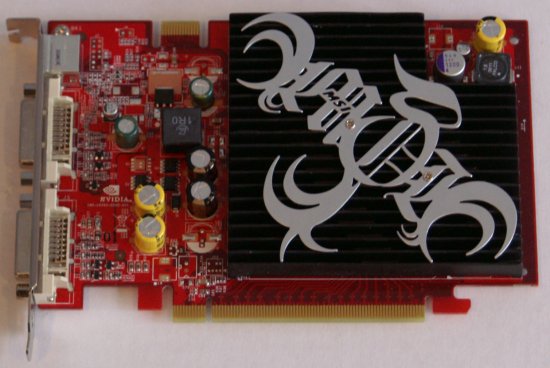
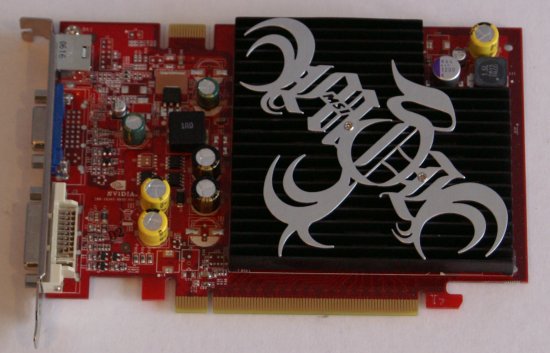
Both MSI cards are clocked at reference speeds, 400MHz and 800/MHz for the 7600 GS, and 350MHz and 667MHz for the 7300 GT. We aren't sure if the Gothic lettering on the heat sinks adds in some way to the cooling of the card, but there isn't much doubt that these cards have the most artistic logo on them out of the rest in our review. The two cards appear virtually identical, with the exception of display connections: the 7300 GT has one DVI and one VGA port while the 7600 GS offers two DVI ports.
Cards Summary and Prices
In total, we have 20 silent GPUs for this review, and this is a large number of cards to keep track of. With that in mind, we have a breakdown of the cards and their prices in this section. Some of the cards are older generation and we don't have prices for them at this time; specifically, the ASUS EN6600 GT Silencer and the ASUS EN7800 GT Top Silent. These two cards have been around for a while and while rare, it is still possible to find them floating around on the market if you know where to look.
Here are the cards and prices:
| Graphics Card Prices | |
| ASUS NVIDIA GeForce EN7800 GT Top Silent | $399* |
| ASUS NVIDIA GeForce EN7600 GS Silent 512 | $138 |
| ASUS NVIDIA GeForce EN7600 GS Silent | $129 |
| ASUS NVIDIA GeForce EN6600 GT Silencer | $178* |
| ASUS ATI Radeon EAX1600 XT Silent | $156 |
| GIGABYTE NVIDIA GeForce 7600 GT | $167 |
| GIGABYTE NVIDIA GeForce 7600 GS | $110 |
| GIGABYTE NVIDIA GeForce 7300 GT | $100-$140* |
| GIGABYTE NVIDIA GeForce 7300 GS | $55 |
| GIGABYTE ATI Radeon X1600 PRO | $95 |
| GIGABYTE ATI Radeon X1600 XT | $110-$170* |
| GIGABYTE ATI Radeon X1300 PRO | $73 |
| GIGABYTE ATI Radeon X1300 | $52 |
| EVGA NVIDIA e-GeForce 7600 GS | $117 |
| SPARKLE NVIDIA GeForce 7300 GS Ultra 2 | $40-$115* |
| ALBATRON NVIDIA GeForce 7300 GT | $90-$140* |
| HIS ATI Radeon X1600 PRO | $95-$110* |
| HIS ATI Radeon X1300 PRO | $98 |
| MSI NVIDIA GeForce NX7600 GS | $115 |
| MSI NVIDIA GeForce NX7300 GT | $77 |
As sometimes happens, some of these cards couldn't be found for sale at the time of this writing (marked with a *), but we still listed a rough idea of what kind of prices we expect them to carry. Keep in mind that these are all silent cards, so prices for a non-silent version of the same card may be very different. This is because it may be more efficient and therefore less costly to design and manufacture a card without any moving parts. On the other hand, with a card like the ASUS EN7800 GT Top Silent, the silent version is likely to be more expensive than its standard competitors, given the radical heat sink design required to keep the card running cool.
While we couldn't find any Gigabyte 7300 GTs available for purchase at the time of this writing, you should expect to pay around $140 or more for this part, depending on the vendor, availability, etc. This is a bit more than a standard clocked 7300 GT like MSI's, but the performance increase we will see from Gigabyte's factory overclock on this card puts it more in competition with the 7600 GS than the 7300 GT.
The Albatron 7300 GT also appears to be unavailable for purchase at this time, but we speculate that it should cost about the same or slightly less than the Gigabyte 7300 GT, given that their factory overclocks are similar. While there is a 50MHz difference in core clock speeds between these two cards, the difference in performance between them will be fairly close (depending on the game and settings) as we will see in the performance section.
We aren't sure about cards like the Sparkle 7300 GS Ultra 2, HIS X1600 Pro and Gigabyte X1600 XT, so we listed a price range that reflects a number of cards of the same type that are available by other manufacturers. There is a lot of overlap here of course, and we can't know for sure what these cards will sell for (or even when/if they will be available for purchase), but we can make some price suggestions for these cards based on their performance and the prices that we have for our other silent cards in this review. The Sparkle 7300 GS Ultra 2 for instance would be a good value closer to the same price as the Gigabyte 7300 GS, given the similarity in performance: probably about $45-$50. The HIS X1600 Pro would be a decent buy at around $95-$100, and the Gigabyte X1600 XT should probably list for around $140-$150, given current prices for this ATI part.
In general, the prices for all of these cards -- with the exception of the older ASUS 7800 GT and 6600 GT -- will range from about $50 to $170 which puts them in the mid-range and budget categories. Higher performance cards generate more heat, and as we mentioned, slower cards are better suited for silent operation. That is why we don't see many fast cards like the 7800 GT and above that are completely silent. As technology improves and cards become more efficient, we will surely see silent cards with much higher performance capabilities, particularly if there continues to be demand for silent solutions.
Overclocking
Overclocking is a valuable tool when looking to get the most out of your graphics solution. Many card manufacturers sell overclocked versions of their cards, often with positive results. A few of the cards we have come with their own factory overclock, but we make a habit of doing our own user-overclocking whenever we can and this review is no exception.
We were able to overclock these cards using Coolbits for the NVIDIA cards, and a handy program called ATI Tool for the ATI cards. ATI tool has a built in 3D view of a rotating fuzzy cube to test the stability of the card while overclocking on the fly. We use this to get our initial overclocks, and then follow this test up with repeated game benchmarks to ensure that the card runs stably (i.e. without any graphical tearing or artifacts). Below is a list of the cards and the overclocks we achieved, as well as their factory clock speeds.
| GPU Overclocking | ||
| Factory Clock | User Overclock | |
| ASUS NVIDIA GeForce 7800 GT | 420/1240 | 481/1290 |
| ASUS NVIDIA GeForce 7600 GS 512 | 400/540 | 483/596 |
| ASUS NVIDIA GeForce 7600 GS | 400/800 | 442/874 |
| ASUS NVIDIA GeForce 6600 GT | 500/1000 | 561/1070 |
| ASUS ATI Radeon X1600 XT | 590/690 | 624/751 |
| GIGABYTE NVIDIA GeForce 7600 GT | 560/700 | 608/734 |
| GIGABYTE NVIDIA GeForce 7600 GS | 450/800 | 549/890 |
| GIGABYTE NVIDIA GeForce 7300 GT | 450/800 | 474/858 |
| GIGABYTE NVIDIA GeForce 7300 GS | 550/800 | 644/851 |
| GIGABYTE ATI Radeon X1600 PRO | 500/400 | 580/432 |
| GIGABYTE ATI Radeon X1600 XT | 590/690 | 621/706 |
| GIGABYTE ATI Radeon X1300 PRO | 600/400 | 650/409 |
| GIGABYTE ATI Radeon X1300 | 450/350 | 610/405 |
| EVGA NVIDIA GeForce 7600 GS | 400/800 | 445/875 |
| Sparkle NVIDIA GeForce 7300 GS | 550/532 | 611/700 |
| Albatron NVIDIA GeForce 7300 GT | 400/800 | 502/884 |
| HIS ATI Radeon X1600 PRO | 500/400 | 597/441 |
| HIS ATI Radeon X1300 PRO | 600/400 | 640/445 |
| MSI NVIDIA GeForce 7600 GS | 400/800 | 441/875 |
| MSI NVIDIA GeForce 7300 GT | 350/667 | 486/830 |
Heat is always an issue when overclocking, and because we are dealing with silent graphics cards, we took extra care when boosting the clock speeds for these cards. Interestingly, all of these cards were able to be overclocked to some degree and saw a degree of performance increase. Of course some overclocked more than others, and there were a few cards that did notably well for us, as our table shows. In particular, the Gigabyte X1300 got a 160 MHz boost in the core clock resulting in about a 23% boost in Battlefield 2 at 1024x768, making the game much more playable at this resolution. The MSI NX7300 GT also got a high overclock in both the core and memory clock. It appears that in general some of the slower cards like the X1300s and 7300s overclock better than the faster ones, which is ultimately good news for those who are limited to the slower cards because of price.
Once we achieved our overclocks for these cards, we again tested performance in Battlefield 2 and Oblivion to get a general idea of the increase in performance with the new clock speeds. As these are two of the most graphically demanding (and popular) games in our testing, their benchmarks are particularly useful to see how well these cards overclock. Keep in mind, however, that how well a card overclocks will vary even between two cards of the same model and manufacturer, so the clock speeds we achieved with our Gigabyte 7600 GS won't necessarily be what you will see with your Gigabyte 7600 GS.
| Battlefield 2 v1.22 Overclocked | |||||
| 800x600 | 1024x768 | 1280x1024 | 1600x1200 | Avg. Increase | |
| ASUS 7800 GT Top Silent (481/1290) | 60.2 | 59 | 58.7 | 57.5 | 1.85% |
| ASUS 7600 GS Silent 512 (483/596) | 61.7 | 56.6 | 43.8 | 32.6 | 11.01% |
| ASUS 7600 GS Silent (442/874) | 60.7 | 57.9 | 47.5 | 36.3 | 5.33% |
| ASUS 6600 GT Silencer (561/1070) | 59.1 | 51.4 | 38.8 | 30.3 | 8.66% |
| ASUS EAX1600 XT Silent (624/751) | 61.7 | 55.3 | 39.9 | 29.2 | 4.96% |
| GIGABYTE 7600 GT (608/734) | 59.7 | 58.2 | 57.5 | 51.1 | 1.44% |
| GIGABYTE 7600 GS (549/890) | 60.6 | 56.6 | 53.4 | 41.7 | 7.64% |
| GIGABYTE 7300 GT (474/858) | 67.3 | 61.2 | 38.3 | 28.9 | 12.60% |
| GIGABYTE 7300 GS (644/851) | 45.3 | 62.2 | 23.4 | 17.1 | 47.40% |
| GIGABYTE X1600 PRO (580/432) | 61.2 | 63.2 | 35.3 | 25.7 | 2.28% |
| GIGABYTE X1600 XT (621/706) | 62.2 | 64.2 | 39.5 | 27.7 | 25.38% |
| GIGABYTE X1300 PRO (650/409) | 47.8 | 65.2 | 23.2 | 16.5 | 30.95% |
| GIGABYTE X1300 (610/405) | 37.6 | 66.2 | 18 | 12.4 | 82.61% |
| EVGA e-GeForce 7600 GS (445/875) | 60.7 | 57.9 | 47.5 | 36.3 | 5.33% |
| Sparkle 7300 GS Ultra 2 (611/700) | 42.3 | 31.8 | 21.9 | N/A | 24.28% |
| Albatron 7300 GT (488/860) | 70.4 | 55.2 | 40.2 | 30.3 | 22.86% |
| HIS X1600 PRO (597/441) | 61.6 | 51.2 | 36.3 | 26.4 | 13.79% |
| HIS X1300 PRO (640/445) | 48.1 | 35.7 | 23.5 | 16.8 | 9.40% |
| MSI 7600 GS (441/875) | 60.6 | 57.8 | 47.5 | 36.3 | 5.25% |
| MSI 7300 GT (486/830) | 68.4 | 53.4 | 39 | 29.3 | 34.63% |
| Oblivion Gate Overclocked | |||||
| 800x600 | 1024x768 | 1280x1024 | 1600x1200 | Avg. Increase | |
| ASUS 7800 GT Top Silent (481/1290) | 59.7 | 56.9 | 47.2 | 37.5 | 4.00% |
| ASUS 7600 GS Silent 512 (483/596) | 42.1 | 32 | 21.7 | 16.3 | 13.32% |
| ASUS 7600 GS Silent (442/874) | 50.7 | 35.6 | 25.4 | 18.5 | 12.29% |
| ASUS 6600 GT Silencer (561/1070) | 40.6 | 27.8 | 19.6 | 14.9 | 16.19% |
| ASUS EAX1600 XT Silent (624/751) | 40.2 | 29.4 | 20.2 | 15.5 | 7.51% |
| GIGABYTE 7600 GT (608/734) | 61.5 | 53.9 | 38 | 27.6 | 8.83% |
| GIGABYTE 7600 GS (549/890) | 52.4 | 42.2 | 28.1 | 21.8 | 14.57% |
| GIGABYTE 7300 GT (474/858) | 38.9 | 29.7 | 20 | 14.9 | 6.79% |
| GIGABYTE 7300 GS (644/851) | 21 | 16.1 | 10.7 | 7 | 18.06% |
| GIGABYTE X1600 PRO (580/432) | 32.4 | 25.2 | 17.4 | 13.5 | 10.61% |
| GIGABYTE X1600 XT (621/706) | 38.7 | 27.7 | 20.9 | 15.7 | 6.11% |
| GIGABYTE X1300 PRO (650/409) | 28 | 19.2 | 12.9 | 9.5 | 11.53% |
| GIGABYTE X1300 (610/405) | 22.4 | 16.3 | 11.2 | N/A | 34.35% |
| EVGA e-GeForce 7600 GS (445/875) | 50.8 | 35.7 | 25.5 | 18.5 | 12.54% |
| Sparkle 7300 GS Ultra 2 (611/700) | 19.6 | 14.5 | 9.7 | N/A | 26.05% |
| Albatron 7300 GT (488/860) | 41.2 | 29.9 | 22 | 15.9 | 19.69% |
| HIS X1600 PRO (597/441) | 35.7 | 27.1 | 19.1 | 13.2 | 17.44% |
| HIS X1300 PRO (640/445) | 26.5 | 18.9 | 13.1 | 8.5 | 6.95% |
| MSI 7600 GS (441/875) | 50.6 | 35.6 | 25.4 | 18.5 | 12.23% |
| MSI 7300 GT (486/830) | 41 | 30.5 | 20.4 | 15.7 | 37.47% |
Now that we have our overclocked performance numbers along side of our factory clocked ones, we can see how well these cards perform overclocked relative to each other. In Battlefield 2, we can see how certain cards that only got borderline-playable framerates at 1600x1200 and 1280x1024 with their factory clock speeds became playable at these resolutions with a bit of overclocking. The MSI NX7300 GT in particular at 1600x1200 gets a 35% increase in frame rate going from 21.7 fps to 29.3 fps. Also, the Gigabyte 7600 GS benefits the most from its overclock to 549 and 890 MHz at 1600x1200 resolution, getting almost a 17% increase in framerate.
In Oblivion, the increases in framerates seem a little more dramatic in the more graphically intensive "Oblivion Gate" benchmark, but we again see a few marked improvements in performance in each benchmark. Again the MSI NX7300 GT and Gigabyte 7600 GS stand out with their performance increases. In this roundup, the Gigabyte 7600 GS sets itself apart from the other three 7600 GS cards (the MSI NX 7600 GS, EVGA e-GeForce 7600 GS, and the ASUS EN7600 GS Silent). Not only is it the only 7600 GS that comes with a factory overclock, but it also manages to achieve the highest user overclock of the four resulting in slightly better overall performance.
Test Setup
We felt it best to include as many games as possible for our performance tests in order to get the best view of how these cards perform on both newer games and ones that have been around for a while. The games we used for our tests are Oblivion, Battlefield 2, Half-Life 2 Episode 1, Quake 4, Rise of Legends, Splinter Cell Chaos Theory, and F.E.A.R. When possible, we ran the benchmarks at four resolutions, 800x600, 1024x768, 1280x1024, and 1600x1200. F.E.A.R doesn't support 1280x1024, so we used 1280x960 instead, and Rise of Legends doesn't support resolutions lower than 1024x768.
Because some of these cards have only 128 MBs of memory, we ran tests at lower quality settings in each of the games for these cards, but we'll deal with these cards in the following "Lower Range Performance" section. We generally test with higher quality settings enabled because we find many gamers prefer to play games with graphics quality settings on high with "bells-and-whistles" like HDR effects, sacrificing their screen resolution to make up for the performance hit (especially given that a large number of gamers still use older monitors that can only display resolutions of up to 1280x1024 or 1600x1200). This isn't the case for all gamers, and many prefer higher resolutions and lower quality graphical settings; but for the purposes of this article we find this to be the best choice for testing.
Something to note is that many of these cards are clocked at the same reference speeds, so we will see several cards with identical numbers in our tests. Because we are dealing with so many cards, comparing performance between them all is somewhat daunting, but we hope to give the reader a good idea of how these cards rank in performance relative to each other for each of the games in the next sections.
This is the system we used for testing:
| Test Bed Components | |
| Motherboard: | NVIDIA nForce4 |
| Processor: | AMD Athlon 64 FX-55 2.6 GHz |
| Memory: | 2x1024MB OCZ 2-2-2-6 DDR-400 |
| Hard Drive: | Seagate 7200.7 120GB |
| Power Supply: | OCZ 600W PowerStream |
*Note that sound was disabled for testing. Testing was also performed in an open air environment rather than inside a case. This eliminated the need for a case fan, but it is not fully representative of how the various cards will run once placed inside a typical case. We will have a future article examining how the various silent cards perform inside a case, and depending on the case and cooling used overall temperatures may be lower or higher. As we stated in the introduction, we would advice some caution for those looking to build a fully silent computer. It is likely easier, cheaper, and more reliable to build a nearly-silent system by using a single low-RPM 120mm fan (perhaps with a voltage mod to further reduce fan speed) than to have an absolutely silent system that overheats under load.
Battlefield 2
Battlefield 2 is a game that has been a valuable asset to our GPU testing, and it's one of our absolute standards for present-day gaming. The game is one of the most popular that we test, and it is still one of the best reasons to upgrade your graphics card. Our benchmark for this game is basically a third-person view of a player on foot and in a few different vehicles, including a jet. This gives us a wide view of the action in the different vehicles and on foot in order to get a test which covers a wide range of gameplay. We tested Battlefield 2 with the graphics settings on "High" quality.
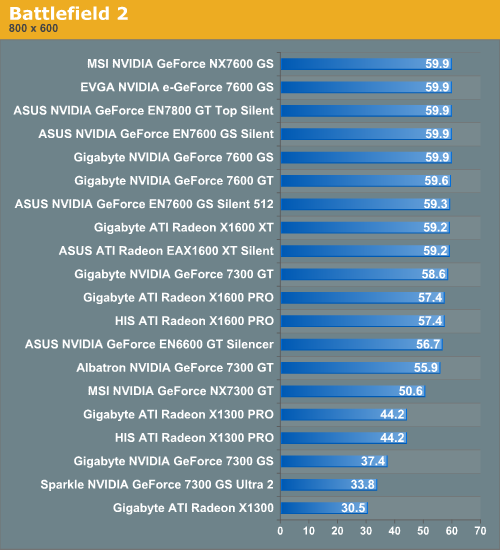
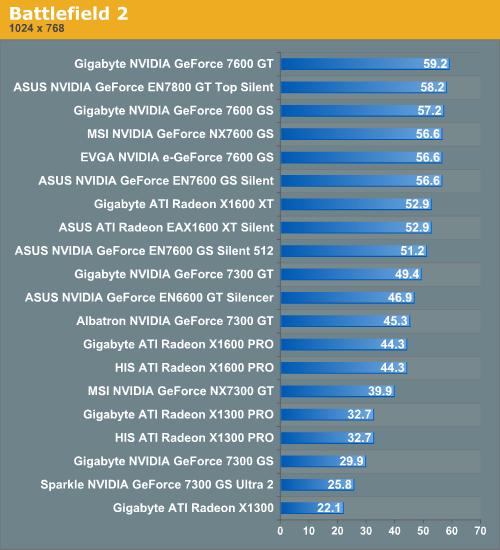
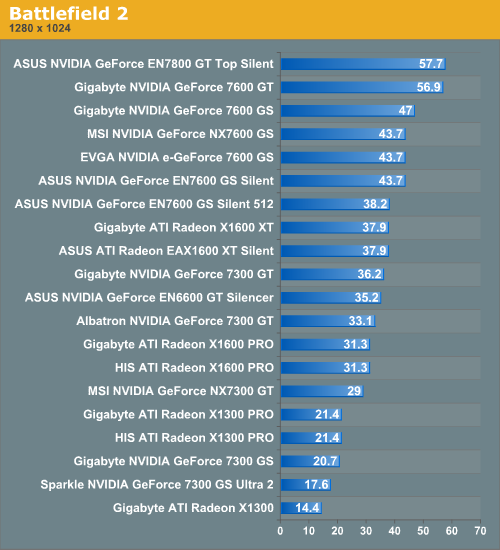
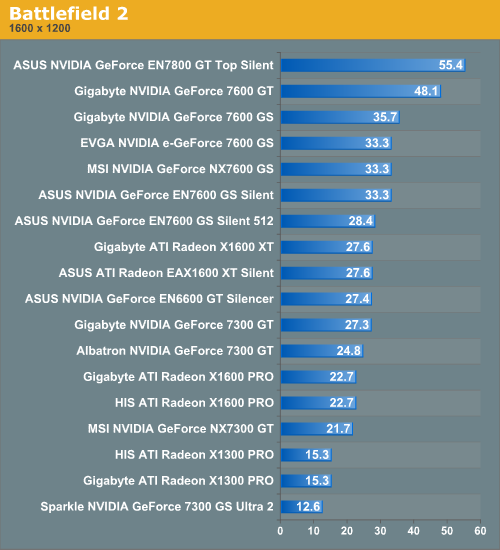
When testing Battlefield 2, we noticed a strange graphical issue with our 7300 GS cards, the Sparkle 7300 GS Ultra 2 and the Gigabyte 7300 GS. For some reason, ground textures show up as white (blank) when in third-person view, and strange motion trails follow the characters and vehicles (as well as some structures). We're not sure why this happens (it's possibly a TurboCache issue, as these cards use this technology), but there aren't any graphical problems when in first-person mode. This will be a significant inconvenience for any BF2 players who like using third-person view (as this editor does) when in certain vehicles like the hum-vee.
A pattern we will see throughout all of these tests is that the ASUS EN7800 GT Top Silent will stand out as the highest performer, particularly in the higher resolutions. This is the advantage of a part that has a higher number of pixel pipelines (20) and is a higher-end part in general. However, with the extra performance comes a higher price tag and higher temperatures, and this silent 7800 GT from ASUS is hard to find on sale at the time of this writing. (MSI also manufactures a silent 7900 GT card which would further improve performance, although unfortunately it is apparently only available in European markets.)
In the graphs above, the first thing we notice is an overhead of about 60 fps at the lowest resolution for a lot of the cards. The game runs well on most of the cards at this setting, and even the slowest cards can run the game at a playable frame rate. Because things like sniping are part of the game play in Battlefield 2, 800x600 is not an ideal resolution unless you are only playing on the smallest maps. 1024x768 is more suitable for medium to large games, so this is something to consider while looking at performance.
We can see that on the low end, the X1300 performs worse that the Sparkle 7300 GS up until you get to the higher resolution. This isn't helpful though because none of these cards are really playable over 1024x768. If you want to be able to play Battlefield 2 at 1600x1200 on "high" quality, you will probably need at least an X1600 XT to do so.
As a side note, we can see how the factory overclocks on cards like the Gigabyte and Albatron 7300 GT and Gigabyte 7600 GS give a few extra frames of performance over the other cards of the same type. Cards like these will naturally have a slight edge in performance over the reference clocked ones which is always something to consider when looking at card prices.
Quake 4
We include the Quake 4 timedemo in our benchmarks to give us a good idea of how well these cards perform on this graphics engine. As we talked about in a previous article, our Quake 4 benchmark gives us results that don't directly reflect actual gaming performance. However, testing shows that performance in the game will be similar if slightly lower than what we show, so we can still get a good idea of how well these cards perform relative to each other.
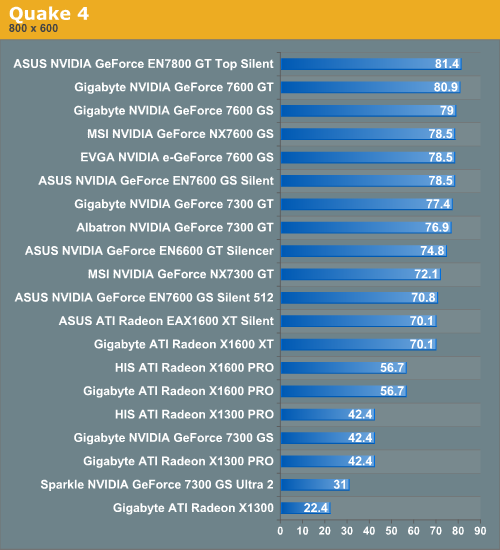
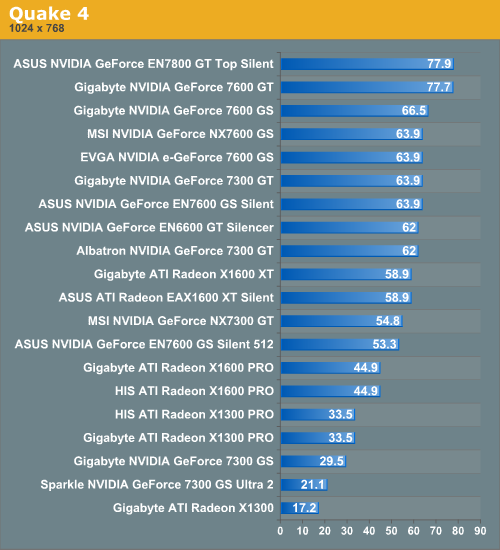
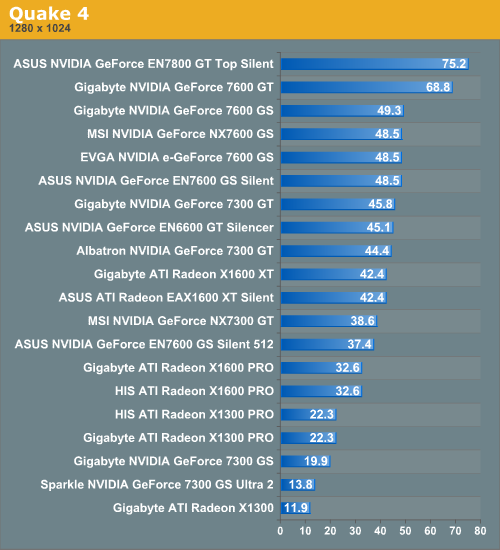
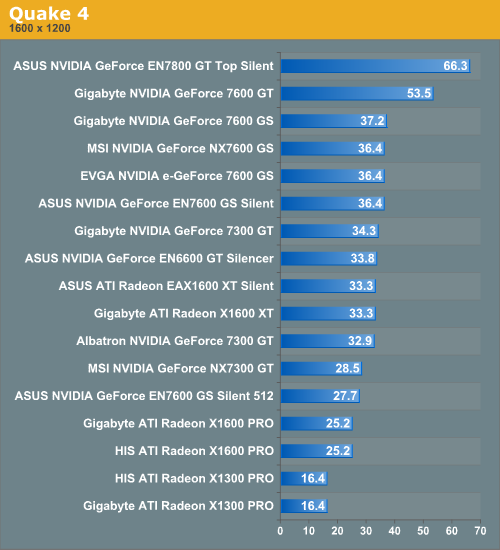
Something we see in Quake 4, as well as the other tests, is that the Gigabyte 7600 GT stands out along with the ASUS EN7800 GT Top Silent particularly at higher resolutions. At 1600x1200, the 7600 GT gets a full 16 more FPS than the Gigabyte 7600 GS; a 44% increase in framerate. This is a big difference but makes sense given that the Gigabyte 7600 GT costs about $60 more than the Gigabyte 7600 GS (about $170 as opposed to $110). However, the Gigabyte 7600 GS and the other 7600 GS cards perform well even at the highest resolution here. The X1600 XTs do well at 1600x1200, but the X1600 Pro does better at 1280x1024. The X1300 Pro and the 7300 GS cards do best at 1024x768 resolution and lower.
Half-Life 2: Episode One
Half-Life 2 has been on our list of games for benchmarking for a long time, and what is great about Valve is that they are continually updating this game, not only in new story content but also graphical content. Half-Life 2: Episode One utilizes newer HDR (High Dynamic Range) lighting effects to give the HL2 engine a new look. The new effects add greatly to the aesthetics of the game, but in addition to this they also add to the game's performance demands. This is a trend in gaming: as games get prettier, faster hardware is required to run them well. Valve has been good about keeping their performance requirements lower than most games of this type however, and that's one of the reasons Half-Life 2 and Half-Life 2: Episode One have been so successful. (The fact that the games are very enjoyable to play also helps, of course.)
We set the detail settings to "high" in the graphics settings for this game. Water detail is set to "Reflect All," and High Dynamic Range is set to "Full (if available)."
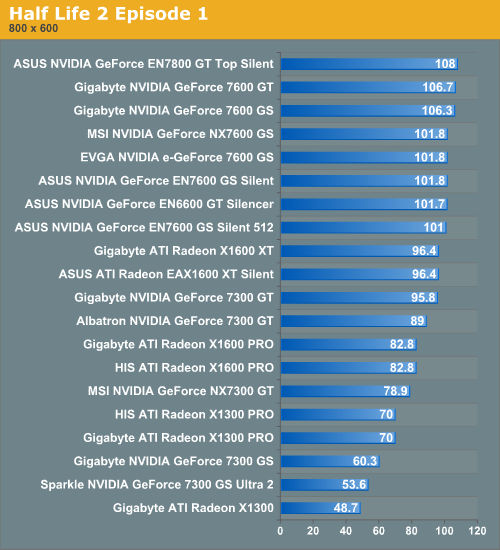

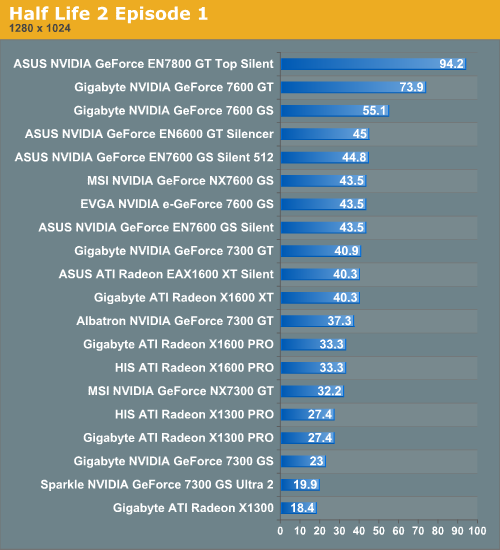
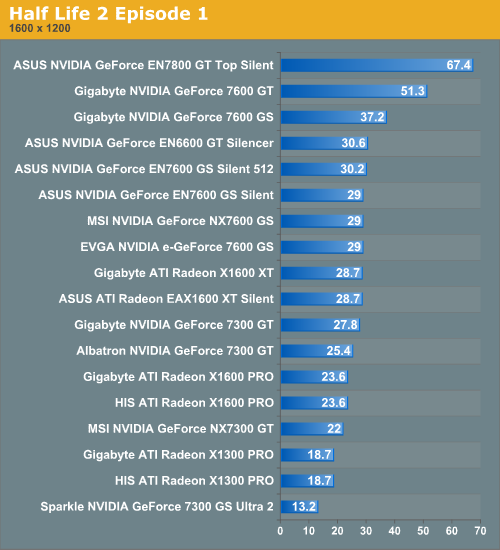
The Gigabyte 7300 GT outperforms the other 7300 GT cards and manages to get framerates closer to the 7600 GS, as we mentioned earlier. The Albatron 7300 GT gets similarly high performance, and only at the highest resolutions do we see a big drop in framerates with these two parts.
The Gigabyte 7600 GS and GT handle 1600x1200 with ease, and most of these cards get playable framerates up to 1280x1024 resolution. Because the action in games like this one is so fast-paced, those with an X1600 XT or 7300 GT might prefer the smoother gameplay they would see at 1280x1024 rather than 1600x1200. (This is assuming the cards are even connected to a display that can handle higher resolutions, which often isn't the case.)
It's also nice that this game can be enjoyed by those with even the slowest cards in our tests (the Gigabyte X1300 and Sparkle 7300 GS Ultra 2) at 1024x768 or 800x600. These resolutions will still provide enjoyable gameplay, especially with all the HDR and water detail effects enabled.
Splinter Cell: Chaos Theory
Splinter Cell: Chaos Theory is a stealth-style game that has been around a while and that we've used many times for testing graphics cards. Because it's more of a slow-paced game and is mostly third-person, it can be enjoyed with a lower fps than fast-paced games like Battlefield 2 and Quake 4. Generally, a frame rate of about 20 FPS is as low as you would want to go when playing this game (depending of course on personal preference). The benchmark for this game is simply a recorded demo of the game play through the first level starting from the beach and ending at the first interrogation cell.
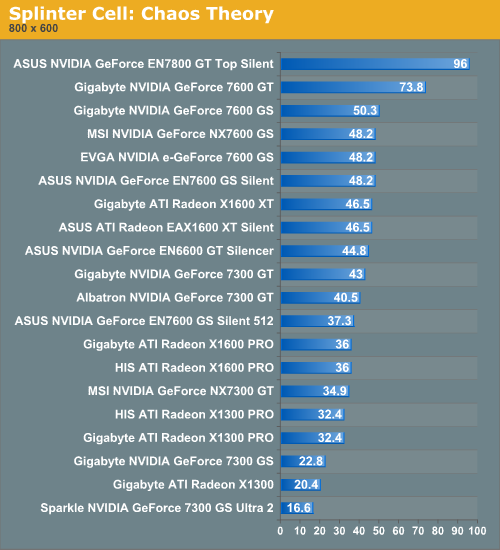


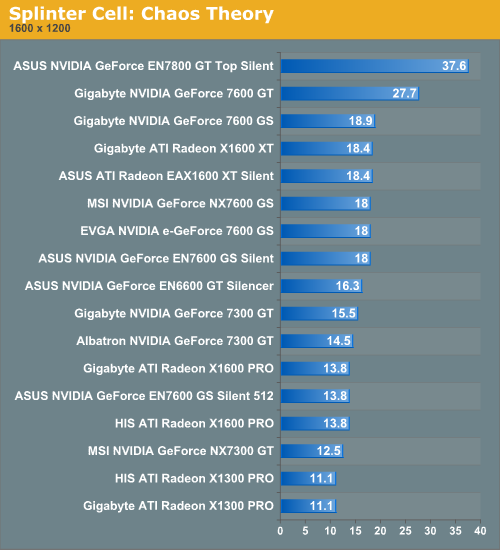
The first thing we notice is that unlike with Half-Life 2: Episode One, ATI hardware generally does a little better than NVIDIA with this game, and it's more noticeable on the low end. The Sparkle 7300 GS Ultra 2 has trouble running this game at all resolutions, but the 16.6 fps at 800x600 might be playable with this card, given the slower gameplay. Almost all of these cards won't be able to run this game smoothly at 1600x1200.
We can see that the X1600 XT performs very similarly to the factory-overclocked Gigabyte 7600 GS across all resolutions in this game, but the price for the Gigabyte 7600 GS is low enough right now that it would still be a better choice than the Gigabyte or ASUS X1600 XT, especially considering it will be a better choice for a lot of other games.
Rise of Nations: Rise of Legends
Rise of Nations: Rise of Legends is a game that we recently added to our list of benchmarks as a good third-person strategy game benchmark. First-person shooter games are always popular but aren't the only games people play on computers, and we need some tests to be able to reflect card performance for all types of games.
This is the first of our "fraps" benchmarks, and it basically consists of a twenty minute recording of a battle between several humans players using different races. We run fraps throughout the whole game (sped up to 4x) to get a good average framerate from start to finish. We test Rise of Legends with the graphics slider all the way to "look better" to enable all of the high quality settings. RoL doesn't support 800x600 resolution, so if you are so unlucky as to have a monitor that is limited to this resolution, you won't be able to play this game (and you probably won't want to use an ATI card because their .NET driver interface won't display properly at 800x600 either).
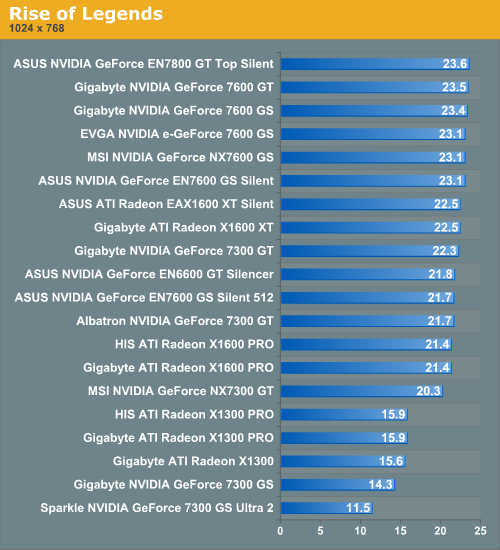
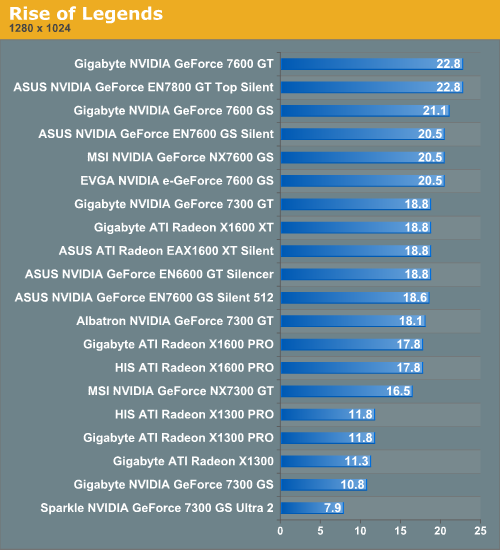
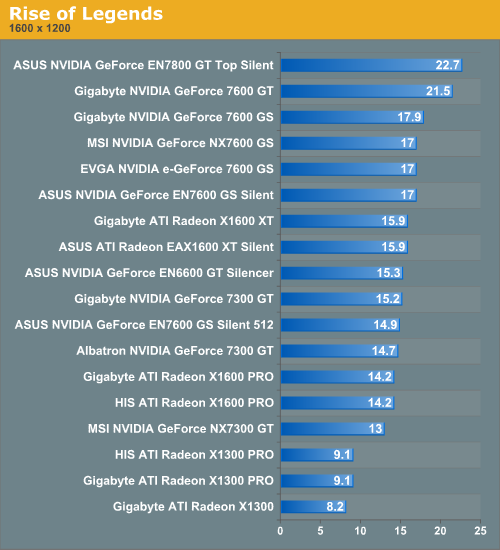
While this isn't a stealth-style game like Splinter Cell, the game is still more playable at lower framerates than other games like Battlefield 2 and F.E.A.R. However, this is much newer game than Splinter Cell: Chaos Theory, and as such it is more demanding on your graphics hardware as our test results show.
A framerate of 20 fps is about the lowest you will want to experience while playing this game, and only the 7800 GT and 7600 GT can achieve this at up to 1600x1200 resolution. Unfortunately this game isn't really playable at any resolution with cards like the X1300 Pro and 7300 GS without turning down the graphics quality settings. If Rise of Legends is your game of choice and you must have one of these silent cards, the Gigabyte 7600 GS is your best option given the performance and price.
F.E.A.R.
F.E.A.R has its own built in benchmark that consists of a fly-through of different game elements such as a firefight between soldiers, an explosion with fire, and hovering over rippling water. We tested the cards with most of the high end settings enabled, turning off soft shadows as we have in the past. We've found that the performance cost of soft shadows isn't worth considering, no matter what card is used, given how poor this effect looks in this game.
As with all the games, we again tested without antialiasing and with filtering set to "trilinear." Since this is another somewhat fast-paced first-person shooter, we consider an average of no less than 25 fps to be acceptable for playable performance.

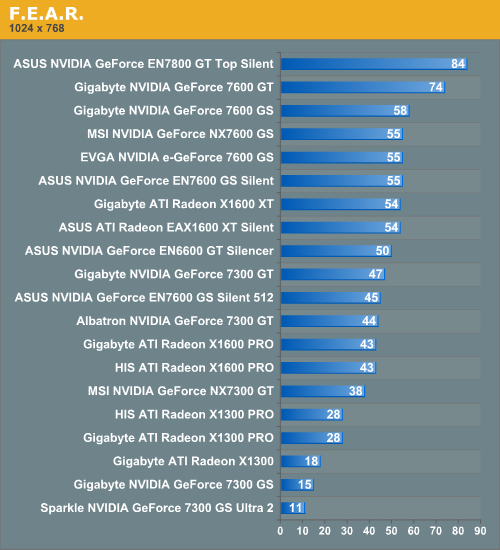
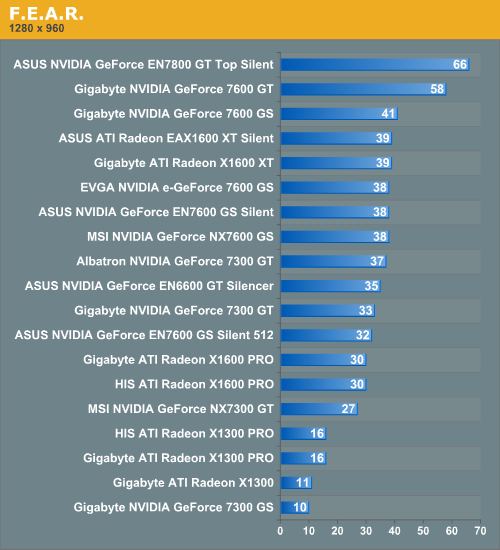
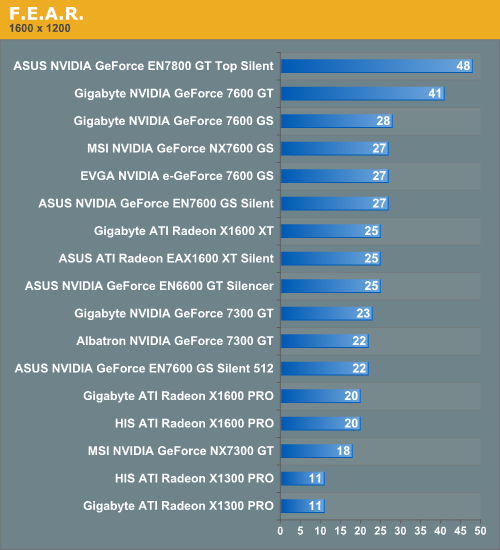
This is another game that seems to favor ATI hardware a bit more than NVIDIA. We again see the Sparkle 7300 GS Ultra 2 at the bottom of the list, and it's not really playable at 800x600, as in Rise of Legends. The Gigabyte X1300 manages to pull off a playable framerate of 29 fps at this resolution. The Gigabyte and HIS X1600 Pro cards do very well up to 1280x1024, and for those who don't mind being limited to 1024x768 the X1300 Pro offerings from the same companies will run this game fairly well. The emerging theme in this article, however, is that the 7600 GS performs better than either of these cards (more or less depending on the game) and it's hard for ATI to compete with the value of the Gigabyte 7600 GS given current prices.
The Elder Scrolls IV: Oblivion
Oblivion is the most graphically intensive game we have for testing the cards in this review. It's also one of the more troublesome games to benchmark because it doesn't have any built-in demo recording/playback features and there is a large variance in performance between the different areas (outside and inside, forests and gates, etc.) of this vast game. In order to resolve this to a degree, we have two separate benchmarks we use for Oblivion: one takes place outside walking towards an Oblivion gate, and the second is in one of the towns (Bruma) walking past several characters in a snowy daylight environment.
Because Oblivion has so much eye candy, having the graphics settings on higher quality (with settings like "distant lands" turned on, and item/actor distances set for longer distances, etc.) can result in a massive performance hit in even high-end graphics cards. Since we are dealing with mid-range and low-end cards in this review, we had to turn many of the quality settings down quite a bit in order to get playable results (and even then some of the cards fall short in the Gate benchmark). Here are the graphical settings we used for Oblivion.
| Oblivion Performance Settings | |
| Texture Size | Medium |
| Tree Fade | 20% |
| Actor Fade | 20% |
| Item Fade | 20% |
| Object Fade | 20% |
| Grass Distance | 0% |
| View Distance | 50% |
| Distant Land | Off |
| Distant Buildings | On |
| Distant Trees | On |
| Interior Shadows | 0% |
| Exterior Shadows | 0% |
| Self Shadows | Off |
| Shadows on Grass | Off |
| Tree Canopy Shadows | Off |
| Shadow Filtering | Off |
| Specular Distance | 20% |
| HDR Lighting | On |
| Bloom Lighting | Off |
| Water Detail | Normal |
| Water Reflections | On |
| Water Ripples | On |
| Window Reflections | On |
| Blood Decals | Off |
| Anti-aliasing | Off |
The first benchmark through the town is less demanding on graphics hardware than the second one with an Oblivion gate. With the "distant lands" setting to off as well as the "view distance" set to 50%, the world seems strangely limited, especially for those who have experienced the game with extended view distances. The game is still technically playable at these settings however.
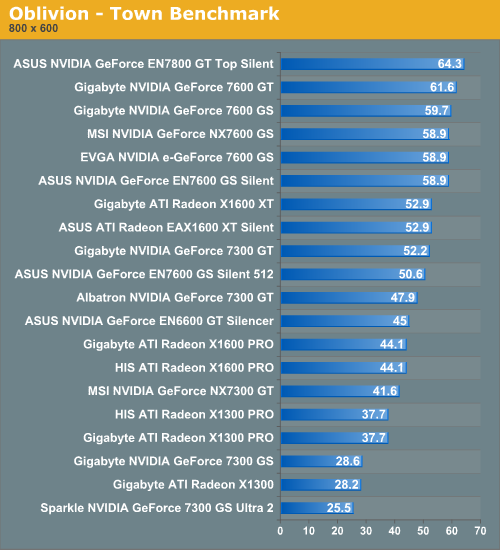
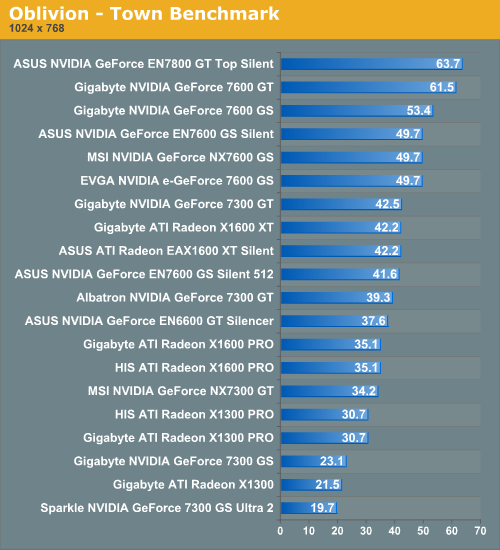
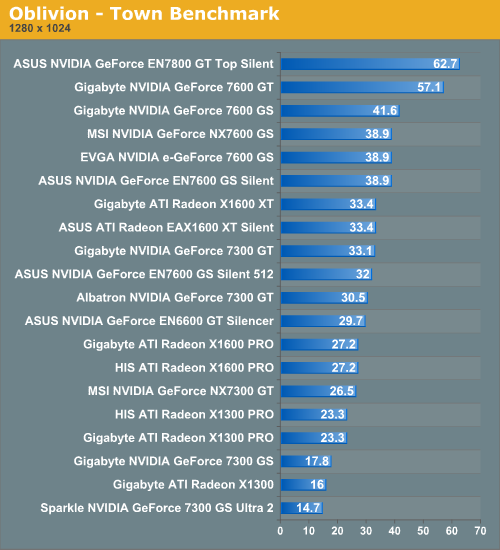
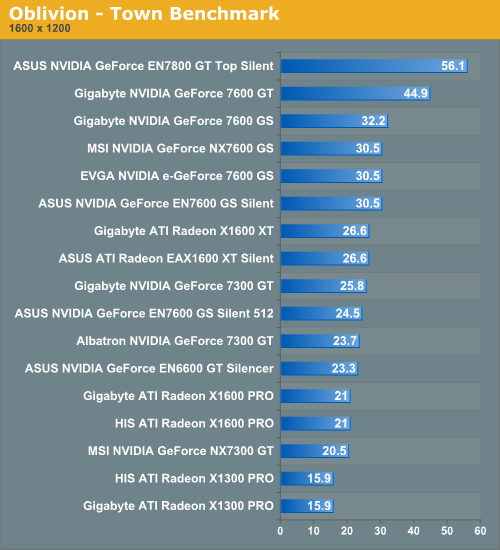
The framerates above show that these cards run this benchmark fairly well, with many cards handling 1600x1200 aside from the obvious issues with 128 MB cards (the Sparkle 7300 GS Ultra 2, Gigabyte 7300 GS, and Gigabyte X1300) and all the ATI cards except the X1600 XT. Not much is going on in this benchmark, however, aside from a few townsfolk walking around and snow falling between the buildings.
For those that have played the game, an Oblivion gate is an impressive visual spectacle to behold, very reminiscent of the "Eye" effect for Sauron in Peter Jackson's epic Lord of the Rings movies. The fact that the second benchmark takes place at night with monsters hurling fireballs at the player makes the effect even more striking, but it also tends to slow the framerate down to a crawl at even the lowest resolutions.
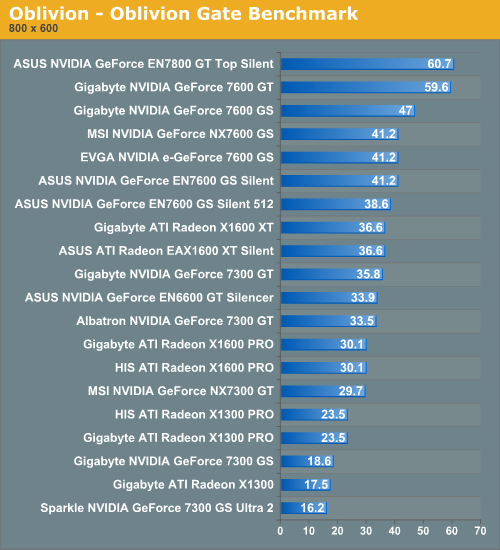
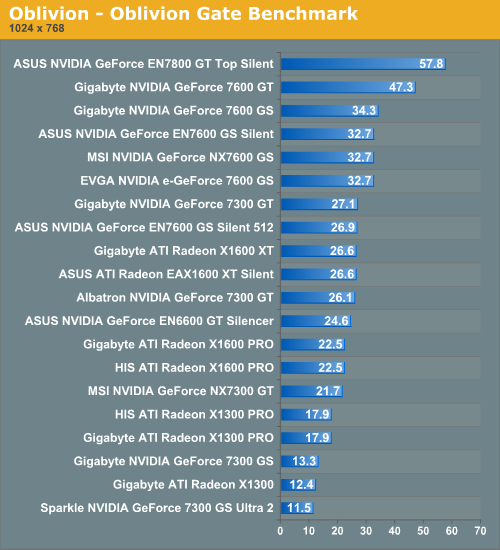
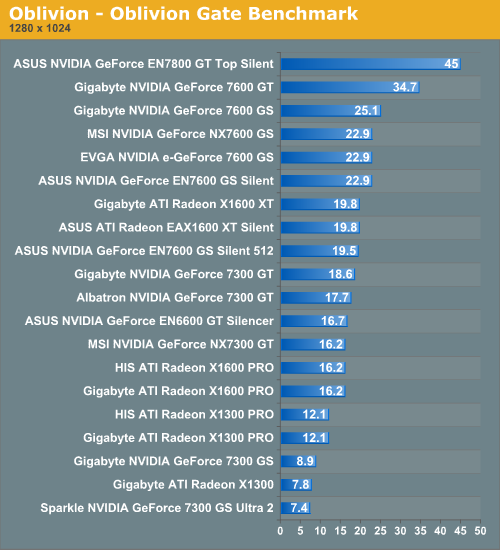
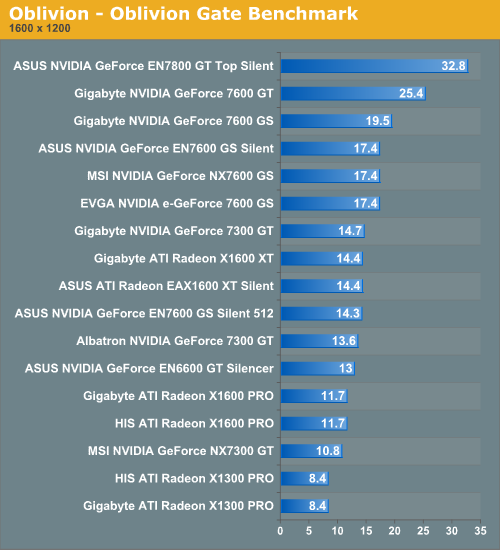
This is one of the only benchmarks we have that could bring the ASUS EN7800 GT Top Silent down to its knees at the highest resolution. Even at the lower resolution of 1024x768 most of these cards see barely playable average framerates. Because this can be a relatively fast-paced game at times, you really don't want to have to deal with framerate issues while battling some of the creatures and characters in this game. Most of the cards run smoothly at 800x600 with this benchmark, but the game isn't very enjoyable at such a low resolution.
This is all with drastically reduced image quality settings already - none of these cards can handle cranking up the eye candy in Oblivion. Unfortunately, this is one of the games that we would recommend not playing with any of these cards, with the exception of the ASUS EN7800 GT Top Silent and perhaps the Gigabyte 7600 GT. We feel a higher-end card is really needed to properly appreciate this game, though opinions vary. It is possible to play the game and even enjoy it with the settings turned way down and at the lowest resolutions, but a great deal of graphical elements are lost, and this is one of those games that relies heavily on graphics to be fully enjoyed.
Lower Quality Performance
Our editorial comments about Oblivion aside, some gamers will attempt to play games like this and Rise of Legends on budget 128 MB cards. This is their God-given right, and we've included some special tests for the slowest of our cards, the Sparkle 7300 GS Ultra 2 at even lower quality settings for Oblivion and Rise of Legends. This is so that we can get an idea of the performance we might expect in games like these with just the most basic graphical elements enabled.
The quality settings in Oblivion for these tests were the same as listed for the normal performance tests, except with HDR effects turned to "off." In Rise of Legends, we set the performance slider exactly halfway between the two choices: "run faster," and "look better." This turns down settings like shadow and special effects details.
| Low Quality Results | ||||
| 800x600 | %Improvement | 1024x768 | %Improvement | |
| Oblivion Town Low Quality | 42.8 | 67.84% | 33.6 | 70.56% |
| Oblivion Gate Low Quality | 23.9 | 47.53% | 17.4 | 51.30% |
| Rise of Legends Medium Quality | 22.1 | 92.17% | ||
For reference, in the town benchmark, the Sparkle card got 25.5 fps at 800x600 and 19.7 fps at 1024x768 in the normal performance tests (with HDR on). In the oblivion gate benchmark, the card got 16.2 fps at 800x600 and 11.5 at 1024x768. This shows us the kind of performance demands that just something like HDR lighting adds to the game. In Rise of Legends, the framerate we got at 1024x768 for the Sparkle 7300 GS Ultra 2 was 11.5.
Both of these games obviously see large improvements in performance with these lower settings as the table shows. While Rise of Legends becomes playable by turning down the graphics settings, this card still has trouble running Oblivion even at 800x600. For those determined enough to run this game on a card like this, it is technically playable, but again we recommend waiting until you've saved up at least enough money for a card like the 7600 GT or X1900 GT.
Power
A card's GPU, clock speeds, and overall design determine the kind of power draw it creates on your system. Moving parts on the heat sink sometimes require more power to run, which is what might give silent cards a slight advantage in this area. However, just because there are no moving parts on a card doesn't mean that it won't still draw large amounts of power. Only one of our cards required an external power connection from the power supply; the rest simply drew their power from the PCIe slot. The ASUS EN7800 GT Top Silent, our most powerful card, required a 6-pin PCI Express power connector, and it's no surprise that we saw the highest power draw from this card.
We tested power by measuring the total wattage of the system with each card installed in two different states. The first state is while the system is idle, without any programs running, and the second state is under load, by running a graphically intensive benchmark. The benchmark we used to stress the graphics cards was 3DMark06, specifically, the fill rate (single and multi-texturing) and the pixel shader tests.
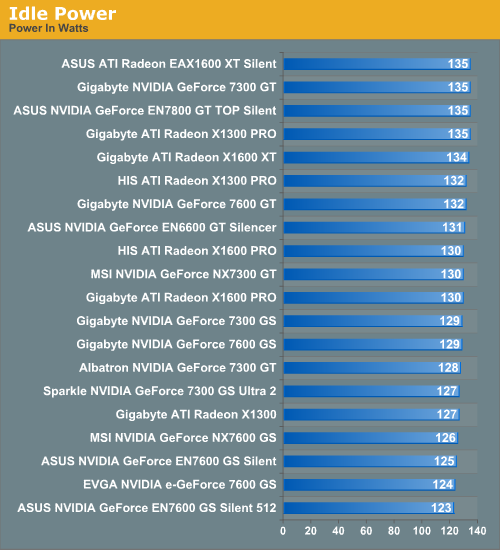
We see initially how while idle, the system draws less power than what you might expect to see for some of these graphics cards. The highest idle power level we see is 135 watts for the Asus 1600 XT and 7800 GT, as well as the Gigabyte 7300 GT and X1300 Pro. The ASUS 7600 GS 512 gets the lowest idle power wattage, which is somewhat interesting as it certainly isn't the least powerful card. With a total difference in idle power of only 10W, though, most of the cards are doing a good job under idle conditions. Let's see what happens when we actually put the cards to work.
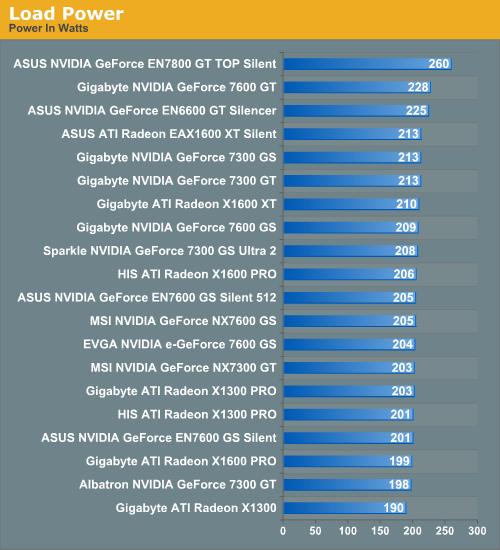
As expected, the ASUS 7800 GT gives the system a significantly higher power draw under load, followed by the Gigabyte 7600 GT, the second most powerful card. The fact that these two cards are the most power-hungry makes sense, as does the fact that the ASUS 6600 GT gets a similarly high load wattage, since this is an older, less efficient part. The Gigabyte X1300 draws the least amount of power under load; this isn't surprising given its low performance, though the Sparkle 7300 GS Ultra 2 is somewhat more power-hungry in spite of the fact that it performs about the same. The Gigabyte 7300 GS, another low-performance card, gets an even higher wattage due to its faster memory.
Aside from the few highest performance cards, all of these cards get very similar results in terms of power draw. This similarity and consistency in power draw among all of these cards seems to say something about the design of silent cards in general. While it is technically possible to cool more power hungry GPUs with a fanless solution, most manufacturers are targeting lower heat GPUs for their silent cards, as the cooling solutions do not need to be as extravagant (or costly).
Heat
As we touched on in the introduction, controlling heat levels is essential to the smooth operation of a graphics card. Because there are no moving parts in any of these cards, their heat sinks must be designed to provide adequate heat dissipation over long time periods, as most people don't sit down to play games for only a few minutes at a time. Whether or not these silent cards run cool or hot will depend not only on the card, but on things like your case ventilation and environment in general. Also, heat levels may vary even among different parts of the same model, but we can get a general idea of the heat that will be generated by these different cards while idle and under stress.
Similar to the way we tested power consumption, we measured the heat level of the card in two different states: idle and after five minutes of stress testing. In order to stress test the card, we would traditionally measure heat levels after a few looped game benchmarks but for this review, we made use of ATI Tool's "Scan for Artifacts" function on their "fuzzy cube" 3D view. This came in very handy for us, because it stresses both ATI and NVIDIA cards by basically drawing a 3D cube with some kind of fuzz map over and over. We found that about five minutes of "scanning" with this tool gave us the same level of stress as running our usual number of Splinter Cell: Chaos Theory benchmark loops, only it was much easier to accomplish the stress testing.
Unfortunately, we weren't able to include any ATI cards in our heat tests, because apparently none of these cards have on-die temperature sensors to give us heat level readings. We were able to use NVIDIA's built-in heat meter in the driver to get readings from the NVIDIA cards, however, so we will look at these numbers for now.

Something we see right away is that the EVGA 7600 GS has a much lower idle temperature than the other cards. The Albatron 7300 GT gets a fairly low temperature while idle, and interestingly the tiny Sparkle 7300 GS Ultra 2 gets the highest idle temperature of the group.

Unsurprisingly, the ASUS 7800 GT gets a dramatically higher temperature than the rest of the cards while under load -- high enough to perhaps warrant some concern. Generally, a core temperature this high is bad news, but it would seem the ASUS EN7800 GT Top Silent was designed to be able to handle temperatures this high. This might be an issue however for someone with poor case ventilation or those who live in a very hot climate without conventional cooling in their building.
The two coolest operating cards under load are the same ones that were the coolest while idle: the Albatron 7300 GT and EVGA 7600 GS, with the Albatron card running slightly cooler. Again we see that the Sparkle 7300 GS Ultra 2 generates quite a bit of heat considering its small size and low performance, though the small size is the likely culprit. The high heat and power load for this card are both negatives, and since it performs very poorly in most of the games the only plus the Sparkle 7300 GS Ultra 2 has going for it is it's small size. It will fit in just about any computer case, no matter how small or crowded it is. This isn't saying much for the card however, and unless you can find it for a ridiculously low price we don't recommend buying one.
Final Words
To give a brief summary of performance, we have the ASUS EN7800 GT Top Silent as the obvious leader followed by the Gigabyte 7600 GT in second place. Depending on the game, the next best card in terms of performance is either one of the Gigabyte, MSI, EVGA, and ASUS 7600 GS cards or either of the ASUS and Gigabyte X1600 XT offerings/ The factory-overclocked Gigabyte 7600 GS scores slightly better than the rest of these, making it the overall third fastest silent card. The next step down would be the ASUS EN6600 GT Silencer, followed by the Gigabyte and Albatron factory-overclocked 7300 GTs. Depending on the game and settings, the HIS and Gigabyte X1600 Pro might do a little better or worse than the reference-clocked MSI NX7300 GT (better generally in Splinter Cell Chaos Theory and Rise of Legends, and worse in most of the other games). Then at the low end you have the HIS and Gigabyte X1300 Pro followed by the Gigabyte 7300 GS. Again in Splinter Cell and Rise of Legends, the Gigabyte X1300 performs slightly better than the Sparkle 7300 GS Ultra 2, and in most of the other games the Sparkle 7300 GS performs the worst.
In terms of Overclocking, the MSI 7300 GT and the Gigabyte X1300 stood out with high core and memory overclocks (135MHz core clock increase in the MSI 7300 GT, and 160MHz core and 55MHz memory clock increase for the Gigabyte X1300) resulting in large performance increases in Oblivion and Battlefield 2 for these cards. The Gigabyte 7600 GS, in spite of already having a 50MHz core overclock, managed to go up nearly 100MHz on the core clock which was an impressive feat for this card. The Albatron 7300 GT is another factory-overclocked card that got a particularly high core and memory overclock: 102MHz higher in the core and 84MHz in the memory clock. The Gigabyte X1600 Pro got a decent 80MHz increase in the core clock and the HIS version of the same card got an even better 97MHz increase in the core. These were some of the examples that stood out when overclocking these silent GPUs.
Some people might have strong feelings about ATI or NVIDIA hardware and drivers, but we feel they are close enough - especially in single GPU solutions - that you can safely go with whatever card offers the most performance at your chosen price point. Both ATI and NVIDIA have certain strengths and weaknesses depending on things like which game and/or settings are concerned, and both have parts to suit most any gamer's needs. In this review, however, we've seen that prices tend to favor NVIDIA cards, particularly with the Gigabyte 7600 GS. This card is simply put a better value than any of the ATI parts. The X1600 Pro is about $15 less, but it can't compete with the Gigabyte 7600 GS, especially considering the card's factory-overclock.
Dealing with such a large number of cards in a roundup of this type can be a bit of a headache, and it's easy to lose track of which cards are which when testing them all. However, after lots of testing, it's interesting to notice how certain cards begin to stand out in a positive or negative way. Not surprisingly, the ASUS EN7800 GT Top Silent stood out at the beginning because of its high level of performance compared to the other cards. The Sparkle 7300 GS Ultra 2 stood out as being one of the slowest and one of the more frustrating cards to test. With the exception of the issues in Battlefield 2, it performed just as would be expected for a card of this type, but we wouldn't recommend the 7300 GS solutions overall. Gigabyte impressed us initially with the sheer number of silent cards they contributed for this article, but they also impressed us later with the quality of their cards and their normal and overclocked performance.
The Gigabyte 7300 GT and Albatron 7300 GT did well in performance testing, but how good these cards actually are depends a lot on the price. Given that the Gigabyte 7600 GS is about $110 it doesn't make much sense to spend only about $10 less for the 7300 GT card. Whether the 7600 GS is a great bargain or the 7300 GT cards cost too much, the conclusion is that paying the extra $10 for the Gigabyte 7600 GS card is the best choice. We would also rule out buying any of the other 7600 GS cards in this review, given the fact that the Gigabyte 7600 GS comes factory clocked higher than any of the others, and is cheaper by anywhere from about $5 to $20. If you don't mind spending about $170, the Gigabyte 7600 GT isn't a bad choice for a silent graphics solution, as it is the second fastest GPU tested and it is actually readily available.
If you only want to spend about $70 on a silent graphics card, the MSI NX7300 GT is a good choice, especially if you plan on doing any overclocking. We recommend this card over the Gigabyte X1300 Pro, which is about the same price but doesn't perform quite as well in most games. For those that don't really play many games or just want a really cheap silent video card, the Gigabyte X1300 is the cheapest card in this group at $52 and will offer basic graphics functionality without making a sound. It's going to be two to four times faster than most integrated graphics solutions, but it will still have trouble running any of the more recent games (like Battlefield 2) at anything but the lowest graphics settings. Without concrete pricing information on many of the other cards, these are our recommendations. None of the tested cards are bad, but given the competition between ATI and NVIDIA as well as the various card manufacturers, it's not surprising that a few of the offerings stand out as being better than others.
 We keep coming back to a single card that strikes the best balance of price and performance. Coming in as the third fastest silent GPU overall and with a price of only $110, we are pleased to award the Gigabyte 7600 GS our Gold Editors Choice Award for Silent GPUs. With a factory overclock of the 7600 GS core and a price lower than competing solutions, there is much to like with the Gigabyte card. It is also a single-slot solution unlike some of the other Gigabyte offerings, making it a card that can work well in HTPCs as well as SFF computers. Our only request now would be for someone to figure out a way to offer a similar price/performance ratio with a faster GPU, though perhaps we're simply being greedy. The Gigabyte card does just about everything right within it's price range, and for that they are to be commended.
We keep coming back to a single card that strikes the best balance of price and performance. Coming in as the third fastest silent GPU overall and with a price of only $110, we are pleased to award the Gigabyte 7600 GS our Gold Editors Choice Award for Silent GPUs. With a factory overclock of the 7600 GS core and a price lower than competing solutions, there is much to like with the Gigabyte card. It is also a single-slot solution unlike some of the other Gigabyte offerings, making it a card that can work well in HTPCs as well as SFF computers. Our only request now would be for someone to figure out a way to offer a similar price/performance ratio with a faster GPU, though perhaps we're simply being greedy. The Gigabyte card does just about everything right within it's price range, and for that they are to be commended. If pure performance (and current availability) is the more important factor, only one card fits the bill. It is with this in mind that we bestow our Gold Editors Choice Award upon the Gigabyte 7600 GT. With a comfortable performance boost that comes with the 55% higher cost over the Gigabyte 7600 GS, we can absolutely recommend the 7600 GT for gamers who are happy with midrange performance and need a quiet card. At a cost on par with actively cooled parts of the same class, we feel comfortable recommending the Gigabyte 7600 GT over other 7600 GTs as well.
If pure performance (and current availability) is the more important factor, only one card fits the bill. It is with this in mind that we bestow our Gold Editors Choice Award upon the Gigabyte 7600 GT. With a comfortable performance boost that comes with the 55% higher cost over the Gigabyte 7600 GS, we can absolutely recommend the 7600 GT for gamers who are happy with midrange performance and need a quiet card. At a cost on par with actively cooled parts of the same class, we feel comfortable recommending the Gigabyte 7600 GT over other 7600 GTs as well.All of these cards offer acceptable performance for non-gaming tasks, and most will at least handle some moderate gaming. More importantly, this is all done while remaining completely silent. Looking at the power and heat results of the various cards, we are interested in seeing what the future holds for silent GPUs. It is doubtful that anyone will create a passively cooled 7900 GTX, 7950 GX, X1900, or other high-end card in the short term. However, Intel has raised the bar on expectations for performance per Watt. If a general purpose CPU can offer a 40% improvement over its predecessor (Pentium D) while consuming 40% less power on average, why can't a GPU revolution accomplish the same thing? Maximum performance may continue to require at least some form of active cooling, but hopefully ATI and NVIDIA can further refine their designs to be more power friendly in the future. With Windows Vista increasing the demands placed on GPUs, the desire to reduce GPU noise levels is only likely to increase.







